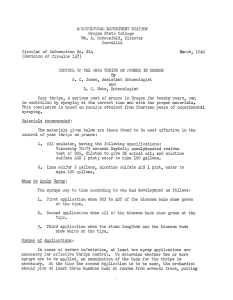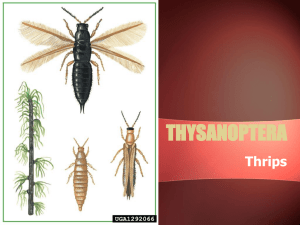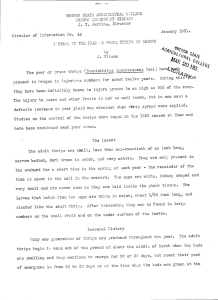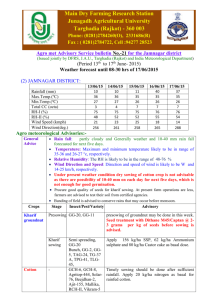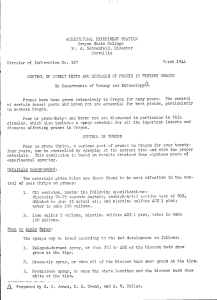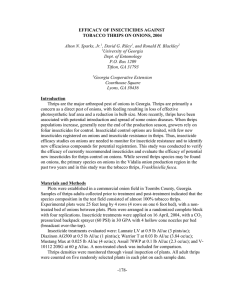AGRICULTURAL EXPERIMENT STATION OREGON STATE AGRICULTURAL COLLEGE L A. Schoenfeld, Director
advertisement
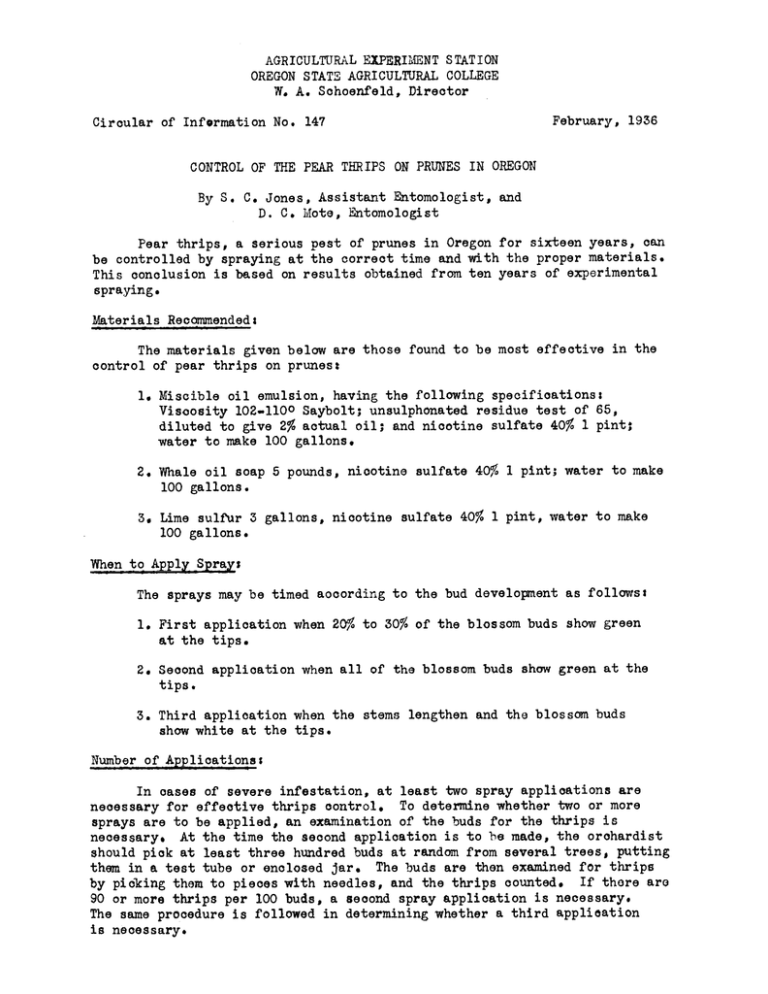
AGRICULTURAL EXPERIMENT STATION OREGON STATE AGRICULTURAL COLLEGE L A. Schoenfeld, Director Circular of Infrmaticn No. 3.47 February, 1936 CONTROL OF THE PEAR TBRIPS ON PRUNES IN OREGON By S. C. Jones, Assistant Entomologist, and D. C. Mote, Entomologist Pear thrips, a serious pest of prunes in Oregon for sixteen years, can be controlled by spraying at the correct time and 'with the proper materials. This conclusion is based on results obtained from ten years of experimental spraying. Materials Recommended: The materials given below are those found to be most effective in the control of pear thrips on prunes 1. Miscible oil emulsion, having the following specifioations: Viscosity 102_1100 Saybolt; unsuiphonated residue test of 65, diluted to give 2% actual oil; and nicotine sulfate 40% 1 pint; 'water to make 100 gallons. 2. VQhale oil soap 5 pounds, niootine sulfate 40% 1 pint; water to make 100 gallons. 3. Lime sulfur 3 gallons, nicotine sulfate 40% 1 pint, water to make 100 gallons. When to Apply Spray; The sprays may be timed according to the bud develonent as follows: 1. First appliostion when 20% to 30% of the blossom buds show green at the tips. 2. Second application when all of the blossom buds show green at the tips. 3. Third application when the stems lengthen and the blossom buds show white at the tips. Number of Applications; In oases of severe infestation, at least two spray applications are necessary for effective thrips control. To determine whether two or more sprays are to be applied, an examination of the buds for the thrips is necessary. At the time the second application is to he made, the orohardist should pick at least three hundred buds at random from several trees, putting them in a test tube or enclosed jar. The buds are then examined for thrips by picking them to pieces with needles, and the thrips counted. If there arc 90 or more thrips per 100 buds, a second spray application is necessary. The same procedure is followed in determining whether a third application is necessary. 2. The schedule given above cannot always be followed precisely duo to rains, winds, or other conditions which occur at the time outlined. It 'nay be necessary, therefore, to spray slightly before or after the time given in the schedule to take advantage of more favorable spraying conditions, The proposed schedule must be followed as closely as possible, however, in order to obtain satisfactory control. Thorough Spraying Necessary: Thrips are likely to be anywhere on the trees. Therefore, the spray should reaoh every part of the tree. The spray materials are contact sprays and must wet the insects to kill them. The spray equipnent should be capable of maintaining from 300 to 350 pounds pressure during the spraying operations. A coarse driving spray will force the spray into the buds bettor than a fine spray and is reoonmended. Preparedness Essential: Spray materials should be on hand. before the buds begin swelling in the spring. Sprayers should be overhauled and put in good condition several weeks bef ore the spray season begins. Success in thrips control may depend on a very few days when spraying is possible. A delay for any reason may mean failure to control this post. Caution: Certain precautions must be taken in spraying to avoid unnecessary injury to the trees. Oil should not he used if lime sulfur is to follow later as a fungicide for the control of brown rot. If oil has been used in the early sprays, use bordeaux instead of lime sulfur. Thrips Come from Soil in Maroh: This inseot has but one generation a year. It spends nine months of the year in the soil, first as a larva and later as a prepupa, pupa and adult. The adults start emerging from the soil about the time Italian prune buds begin to swell in the spring. In normal years the seasonal peak is reached when from 20% to 30% of the blossom buds show green at the tips. Thrips enter the buds as soon as the bud scales soparate and feed on the young fruit stem at the base of the blossom bud. Egg laying begins in about 20 days after emergence. Thrips larvae (white thrips) may be found during the blossoming period. The larvae mature in about three weeks, depending on weather conditions, and either fall voluntarily to the ground or aro blown or waehod off by rain. The larvae enter tho soil through any convenient opening that is available to them, They may penetrate the soil from 4 to 36 inches, depending on soil texture. Most of the larvae, however, may be found at depths from six to ten Inches, and it is rare to find them as deep as 36 inches. Thrips Cause BlosBom Blight and Prune Russet: It is important to the grower that he learn to recognize the injury caused by this insect. The most pronounced injury is caused by the adult thrips early in the season before the blossoming period. It is brought about through the feeding habits of the adults. The blossom stems become devital. ized and fail to lengthen. Later the blossøm opens only partially or not 3. at all, and soon falls from the tree. An infested orchard becomes browiish had been fire-swept. Often this type of inur is referred to as "blasting" of the buds. Those blossoms which escape/i are often devitalized by thrips when they are in full bloom. The stemens and pistils of the flower parts are attacked by the thrips and injured so badly that the does not set, The fruit stems sometimes become so perforated with egg punctures that premature dropping of the results in late spring and early summer. The larvae feed on the young fruit, causing considerable of the well knon prune russet. They also feed upon the foliage, usually along the leaf veins, killing the tissues and causing "raggingt' of the foliage later in the summer. in color as if it fruit fruit
